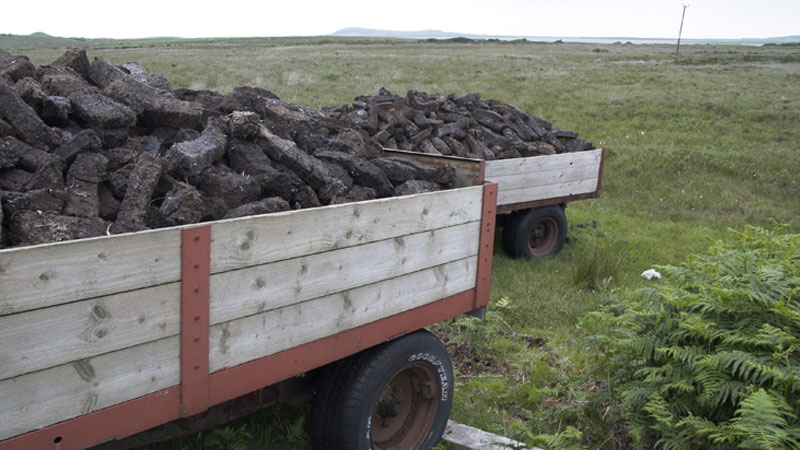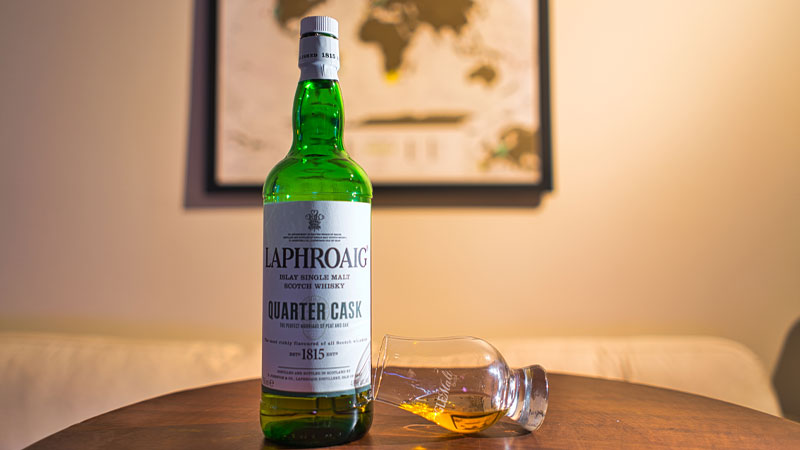For aspiring home bartenders, coaxing value out of a fledgling liquor collection means finding bottles that offer versatility. A few “all-rounders” — spirits that work well in a range of cocktails but can also be sipped neat — go a long way.
When considering aged spirits that meet these criteria, peated Scotch is not an obvious option. The complex, smoky notes that typify the category are polarizing on their own, and can easily overpower other spirits and modifiers when mixed in cocktails.
But with a delicate touch and careful consideration of the whisky in hand, this powerful style of Scotch can be tamed to add smoky swagger to any home bartender’s cocktail repertoire. Better yet, when matched with the right foods, peated whiskies offer some of the most wonderful food pairings imaginable and can even be incorporated into dishes themselves.
Where Peated Scotch Gets Its Flavor
Peated Scotch whiskies gain their intense earthy, smoky profile during the drying of malted barley, which occurs prior to distillation. Certain distilleries, most notably on the isle of Islay, burn decomposed organic matter (peat) to dry out the grain so that it can be fermented and distilled. When it burns, peat emits an odorous smoke that soaks into the malted barley and carries through to the distilled spirit.

Islay distilleries such as Ardbeg, Bruichladdich, Laphroaig, and Lagavulin provide some of the most well-known examples of peated Scotch. Though rarer, similarly smoky styles can also be found in other regions of Scotland, and from a handful of whiskey-producing nations around the world, including Japan, Ireland, India, America, and even Sweden, the original is a good place to start your exploration.
(Most of the aforementioned regions outside Scotland don’t have the correct environmental conditions to produce peat, so distilleries have to either import peat or peated malted barley to produce the smoky style. Nevertheless, their whiskeys share similar flavor and aroma profiles to peated Scotch, and can substitute for all the Scotch suggestions listed below.)
How to Use Peated Scotch in Cocktails
At San Francisco’s Elixir, a cocktail bar with a mightily impressive whisky list and a history that stretches back over 150 years, Dan Burns crafts peated cocktails to satisfy all smoke tolerances.
If you enjoy an intense, peated dram, he’ll serve you a classic whiskey-based cocktail made using an Islay whisky. “Obviously you’re going to get a lot more of the peat than the other ingredients,” he says, “but something like an Old Fashioned — that’s a cocktail that’s supposed to celebrate the principal spirit anyway.”
For those who prefer peat to play a supporting role, Burns incorporates much smaller amounts into his cocktails, using it as a seasoning rather than the base for the drink.
Elixir’s Wild Pony cocktail, for example, blends (unpeated) Toki Japanese Whisky with Cardamaro, a wine-based aperitif, and pear brandy. A “mist” of Laphroaig sprayed from an atomizer adds the finishing touch, much like the peated single-malt float served over a Penicillin. “It gives this beautiful bouquet on the nose, but without the overly heavy peat flavor,” Burns says.
Simon Brooking, a Scotch whisky ambassador for Beam Suntory (Laphroaig’s parent company), recommends a similar approach. “I would suggest swirling a few drops of Laphroaig in your glass as a rinse,” he tells VinePair. “It can be the perfect smoky addition to your vodka or gin Martini.”
To match the powerful profile of peat, Ewan Gunn, Diageo’s global master of whisky, turns to the sweet notes of cola. Its vanilla sweetness counters the whisky’s smoky intensity, and the combination comes with the added bonus of “gleefully outraging some die-hard (and often closed-minded) whisky snobs,” he says.

How to Pair Peated Scotch With Food
For food pairings, Gunn chooses game meats like venison, grouse, and pheasant, whose intense flavors match those of peated Scotch. As an alternative, he says the sharpness of blue cheese cuts through the “smoky earthiness” of whiskies such as Lagavulin.
Burns and Brooking highlight seafood as a worthy partner to help bring out the mineral, saline notes of the whisky. Best of all, they say, is peated whisky and oysters.
Known by many in the whisky business as an “oyster luge,” there are a few different schools of thought on how to properly execute the pairing. Some choose simply to follow the oyster with a shot of the whisky, while others add a dram of peated Scotch into the oyster shell along with the brine and mollusk, and consume all three together.
Others go even further and follow a careful ritual that involves first sipping the oyster brine from the shell, washing it down with a splash of Scotch, eating the juicy oyster, and finally refilling the shell with one final generous dram.
For an island whisky made by the sea, there’s simply no better send-off.
(As a former chef and current drinks writer, I’m wary of placing too much importance on food and drinks pairings; they should be viewed as suggestions and not rules. But then there are combinations so singularly exquisite, I believe everyone should try them at least once in their life: Peated whisky and oysters is one such pairing.)
How to Cook with Peated Scotch
Another delicious interaction between seafood and peated Scotch sees it used as a seasoning when curing salmon. Riffing on Scandinavian gravlax, in his book “Hacking Whiskey,” VinePair contributor Aaron Goldfarb suggests using an Islay Scotch to create “Single-Malt Lox.”
“I’ve always liked lox on my bagels,” he writes, “but, hmmm, they’re never quite Scotchy enough now, are they?” VinePair’s very own recipe for gravlax can be adapted as such, simply by swapping out the aquavit for peated Scotch, and omitting the caraway seeds, juniper berries, and dill.
Home cooks can also utilize the smoky notes of peated whisky as a substitute for a smoker when preparing and cooking meats. “Laphroaig 10 Year Old is a great addition to a basting sauce for your brisket,” Brooking says, while Burns recommends whipping up a glaze by reducing an Islay whisky with honey and lemon.
In the end, it’s all about personal — and admittedly, expensive — experimentation. Whether you’re mixing a peated Scotch cocktail, searching for the ideal food pairing, or experimenting in the kitchen, a little splash of peat goes a long way.